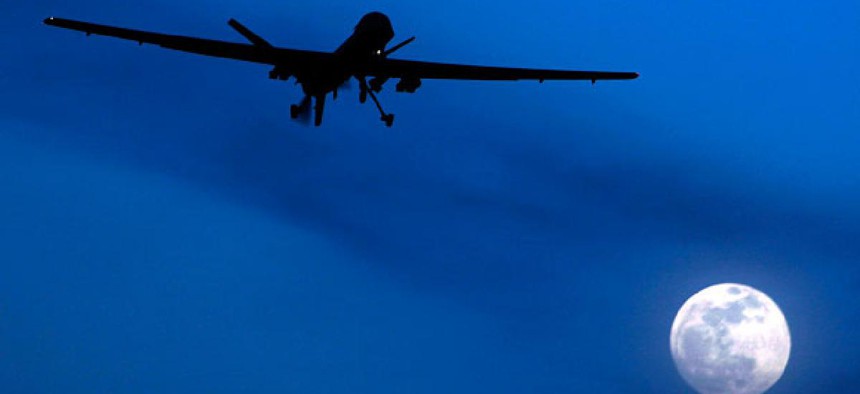No Existing Technology Can Ensure Drone Safety, GAO Official Says

Kirsty Wigglesworth/AP file photo
Unmanned aircraft operations need more spectrum, could be hit by GPS jamming.
No suitable technology currently exists to ensure that drones will “sense and avoid” other aircraft, Gerald Dillingham of the Government Accountability Office recently told lawmakers, adding that the Federal Aviation Administration lacks sufficient dedicated frequency spectrum to operate unmanned aircraft systems in domestic airspace.
Additionally, non-encrypted GPS navigation signals leave drones vulnerable to jamming and spoofing, according to Dillingham, GAO’s director for physical infrastructure issues, who testified Friday at a hearing held by the Oversight Subcommittee of the House Committee on Science, Space, and Technology.
Last Thursday, FAA kicked off a process to set up six test sites to conduct drone research and development toward a goal of widespread use of UAS by law enforcement agencies, universities and other organizations in domestic airspace by 2015. Rep. Ted Poe, R-Texas, estimated that, by 2030, “30,000 drones will be cruising American skies.”
Karlin Toner, director of FAA’s Joint Planning and Development Office, told lawmakers the agency “will not integrate UAS unless and until we can be assured the safety of the [National Airspace System] will not be degraded.” FAA last March published a UAS research and development roadmap detailing projects to advance drone sense-and-avoid technology and secure control communications systems. The research effort includes an assessment of the human factors associated with operation of unmanned aircraft and calls for establishment of maintenance and repair standards, Toner said.
Dillingham told the hearing that while no technology exists today to ensure drones can avoid other aircraft, officials at the Defense Department, FAA, NASA and MITRE, a federally funded research organization, suggest that “potential solutions to the sense-and-avoid obstacle may be available in the near term.” Dillingham said the Army has developed a ground-based system, but did not provide any details, and added NASA recently demonstrated an airborne transponder for drones that is similar to technology manned aircraft will use to automatically report their positions in the FAA’s Next Generation Air Transportation System.
Edgar Waggoner, director of NASA’s Integrated Systems Research Program Office, which is helping FAA with its drone research, testified that drone pilots may have to contract air traffic controllers more frequently than pilots of manned aircraft to avoid traffic, increasing controller workload.
Lack of dedicated and protected spectrum for UAS operations “remains a key security and safety vulnerability” to drone operations, Dillingham testified, as “interruption of radio transmissions can sever the UAS’ only means of control.”
The International Telecommunications Union allocated the 5030-5091 MHz frequency band for UAS control at the 2012 World Radio Conference, but the National Telecommunications and Information Administration has said it needs and plans to seek additional spectrum at the 2015 conference.
Jamming UAS GPS signals could interrupt command and control of drones, interfering with their ability to determine location, altitude and direction, Dillingham said, a situation that could be mitigated by a second navigation system. Spoofing GPS signals could allow an unauthorized user to take control of a drone; to prevent this, Dillingham recommended any UAV larger than 18 pounds be equipped with a spoof-proof navigation system.
Dillingham also said FAA needs to establish standards, processes and procedures to deal with what he called the “lost link scenario,” when communications systems on unmanned aircraft cease to function, potentially leading to loss of control. The Defense Department experienced 72 drone crashes from 2001 through 2012, according to data compiled by the Air Force, with sixteen of those crashes resulting from lost communications.
Toner told the hearing that the challenges of integrating drone operations into domestic airspace are “extremely complex” and said the agency will work to ensure unmanned aircraft can operate safely by 2015.
“We need to identify potential security features or mechanisms to protect UAS operations against threats, such as IT system threats, radio link threats, and human or physical threats,” she said. “FAA is currently collaborating with NASA on a UAS prototype architecture that will be used to develop a high-level security risk assessment.”






